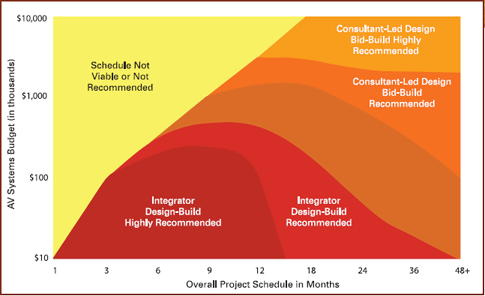Assembling the Design Team

Just like the preparation of a meal, a successful AV project requires the participation of a team of "chefs," each with their own specialty and area of responsibility. And, like any dining experience, success depends on your expectation of the outcome. With AV systems, the outcome is defined by the owner and the design team, whose composition depends on the nature and scope of the project. Modern AV systems interact at almost every level with the spaces in which they are used. Acoustical, interior design, and other building trades can play a role in the successful outcome of an AV project. Professionals representing each of these areas (and more) can be valuable contributors to the AV project.
Who should be on the team? Industry experts suggest that it depends on the specific nature of the project. "The number one question might be, 'Are we going to build a new building or renovate a building?' " says Mark Valenti, president/CEO of the Sextant Group, a Pittsburg, PA-based AV consulting firm. "That will define other players on the team who will influence the decision of the AV provider. The next question would be, 'Should we use an AV consultant or AV systems integrator?' " For some AV users, the question of whether to hire an AV consultant or systems integrator may prompt the more fundamental question: What is an AV consultant? What is an AV systems integrator?
- THE ROLE OF AV PROFESSIONALS
- Independent AV design consultants determine the best options for the design of a system, and they produce specifications for the job that can be then competitively bid by qualified systems integrators or negotiated with a preferred integrator. Some of the areas typically within the AV consultant's area of expertise include video, audio, data, acoustics, lighting, and electric power and infrastructure requirements to support these technologies and systems.
- The traditional role of the integrator has been to provide installation and wiring of physical systems. However, many integrators offer a wider range of services, including consulting and design. When design, consulting, and installation are combined and offered by a systems integrator, the service is referred to as the "design-build" method of delivery.
"If you're walking into a corporate boardroom that's been fitted with AV in the past, and you're the new technology manager tasked with managing the project, you may do very well by bringing in a systems integrator who can adapt the existing facility with new technology," says Valenti, who is also currently serving as president of InfoComm International, a non-profit association serving the professional AV communications industry. "On the other hand, if your boss walks in and says, 'We're constructing a new headquarters - this is your responsibility,' you might need a consultant to help guide the architect."
THE AV DESIGN TEAM
While the AV design team always includes AV professionals, a wide range of other construction industry professionals can also play important roles. Since AV systems are commonly integrated with other building systems, and installation often requires use of existing infrastructure, involvement of these other trades can be critical. As an example, Valenti recalls a recent experience, "I was standing outside one of my consultant's offices and he was having a conversation with the architect, and they were trying to re-orient the particular space to accommodate the AV. I heard the consultant say, 'No, we can't do that, that's the wet wall." Having the plumbing consultant available to the design team can clearly prevent installation disasters.
Here are some typical design team members, and the roles they may play in AV systems design:
Architect: Responsible for the overall design and functionality of the building, as well as life safety and building code compliance.
Interior Designer: Responsible for furnishing and aesthetic appearance of the building's interior spaces.
A daily selection of features, industry news, and analysis for tech managers. Sign up below.
Mechanical Consultant: Primarily responsible for systems such as heating, ventilation, and air conditioning (HVAC), especially as they relate to heat-producing AV equipment and its location within a building.
Electrical Consultant: Designs the high-voltage power distribution systems, as well as conduit and cable tray layouts to support low-voltage systems. For AV systems, the electrical consultant may also be involved with transient voltage and surge suppression (TVSS) systems, uninterruptible power sources (UPS), and an isolated ground system for AV gear.
Plumbing Consultant: Needs to communicate and work with AV designers in the routing and location of water pipes as they relate to AV and electrical infrastructure.
Structural Consultant: Fundamental decisions and knowledge of building load capacities are important since large audio and video systems require significant structural support. The structural consultant provides these perspectives and may also play a role when building structural members could potentially interfere in issues related to sightlines.
AV Designers: The AV designer can be either an independent AV consultant or a staff member within an AV design-build system integration firm. The AV designer's role is to analyze end-users' needs and translate those into AV system and infrastructure design.
Lighting Consultant: Responsible for required lighting and specialized lighting control in spaces where AV systems are used.
Network/Data/Telecom Consultant: Since AV systems have become integrally tied to IT systems, consultants in these areas play a key role in the overall functionality of the successful AV project.
Acoustical Consultant: Analyzes the effect of building materials and interior design on the acoustical environment, and determines treatments or building plan alterations that best address any potentially negative acoustic conditions.
Security Consultant: Responsible for equipment such as cameras, microphones, video recording equipment, and displays that may be used in security systems design and share infrastructure such as network access.
Life Safety Consultant: Life safety issues typically involve audio and/or visual alert systems, which may be tied into operating AV systems.
Other Industry or Trade-Specific Consultants: Depending on the specific customer, other "industry-specific" consultants (such as landscape professionals, civil engineering, or door hardware) may be required to play a role in the AV design team.

MATCHING THE DELIVERY METHOD TO THE PROJECT
According InfoComm International's publication, "Audiovisual Best Practices," finding an AV provider best suited to a particular AV job requires some understanding of the different options of project delivery. An AV project is often described by the method of delivery - as either a consultant-led "design-bid" project or an integrator-led "design-build" project. The obvious difference lies in which professional leads the project, and whether the owner is required to solicit competitive bids before selecting the AV provider.
In the consultant-led "design-bid" project, the independent consultant develops some (or all) of the infrastructure and electronic systems designs, and monitors their installation. The consultant is usually contracted to the architect, although occasionally they may be contracted directly to the building or facility owner. The "design-bid" method is typically used in larger new building projects, where the total AV project is expected to exceed $750,000.
However, if the project schedule is too short (typically less than six to nine months), it may prevent this method from being a viable option.
When the integrator is hired to provide both the design and installation of the AV project, it is called a "design-build" project. This method of delivery is usually best for smaller projects (less than $100,000) or those with a compressed time frame (less than a year).
Once the method of delivery is determined, the owner and their team works with the design team to determine the best recipe for success. Of course, the proof of the pudding is in the eating. In any AV project, success is determined by the quality of the end-user's experience with the system, and a positive experience is only possible as a result of a true team effort.
